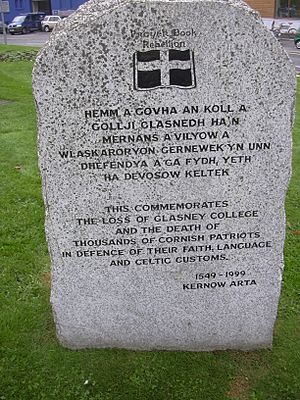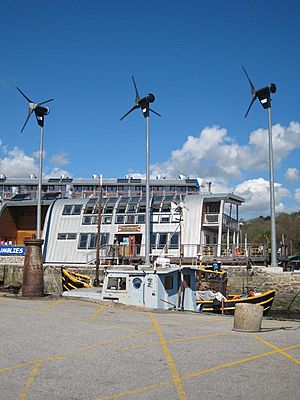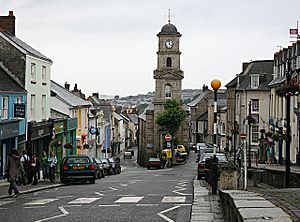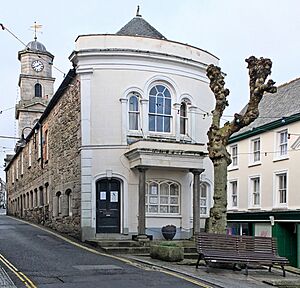Penryn, Cornwall facts for kids
Quick facts for kids Penryn
|
|
|---|---|
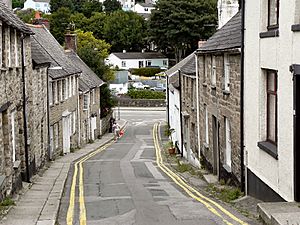 St Gluvias Street, Penryn |
|
| Lua error in Module:Location_map at line 530: Unable to find the specified location map definition: "Module:Location map/data/Cornwall (mainland)" does not exist. | |
| Population | 6,812 (Census 2011) |
| OS grid reference | SW782345 |
| Civil parish |
|
| Unitary authority | |
| Ceremonial county | |
| Region | |
| Country | England |
| Sovereign state | United Kingdom |
| Post town | PENRYN |
| Postcode district | TR10 |
| Dialling code | 01326 |
| Police | Devon and Cornwall |
| Fire | Cornwall |
| Ambulance | South Western |
| EU Parliament | South West England |
| UK Parliament |
|
Penryn (pronounced pen-RIN) is a town and a local government area called a civil parish in west Cornwall, England. It is located on the Penryn River, about 1 mile (1.6 km) northwest of the larger town of Falmouth. The name Pennrynn comes from the Cornish language and means 'promontory', which is a piece of land that sticks out into the sea or a river.
Even though Falmouth is bigger now, Penryn was once a very important harbour. In the medieval period (a long time ago, between the 5th and 15th centuries), ships carried granite and tin from Penryn to other parts of the country and the world.
Contents
History of Penryn: How the Town Grew
Early Days: When Was Penryn Founded?
Penryn is a very old town. It was first mentioned in the Domesday Book (a famous survey from 1086) under the name "Trelivel". The town was officially founded and named Penryn in 1216 by the Bishop of Exeter.
In 1236, Penryn was given a special document called a Charter of Incorporation. This charter gave the town certain rights and freedoms. A religious college, called Glasney College, was built in Penryn in 1265. It helped the church become more influential in this far western part of England.
In 1374, the chapel of St Thomas was opened. Penryn was an important port in the 15th century because its location at the head of the Penryn River offered good shelter for ships.
Changes Over Time: The Dissolution and Civil War
During the reign of King Henry VIII, the Roman Catholic church was changed, and many religious buildings were closed down. This was called the Dissolution of the Monasteries. Glasney College was closed and torn down in 1548, during the time of King Edward VI. This event helped cause the Prayer Book Rebellion in 1549, a protest against the new religious changes.
From 1554, Penryn had its own representative in Parliament. Later, this became the Penryn and Falmouth constituency. This continued until 1950, when Penryn became part of the Falmouth and Camborne area for Parliament.
In 1621, Penryn received a royal charter as a borough. This was partly to help stop piracy, as some mayors of Penryn were involved in piracy between 1550 and 1650. The town's coat of arms showed a Saracen's head.
By the mid-17th century, Penryn's port was busy trading Cornish fish, tin, and copper. However, Penryn supported the Parliament during the English Civil War (1642–48). Because of this, the town lost some of its important trading rights to the newer town of Falmouth.
In the early 1800s, granite quarries were set up by the river. Large amounts of granite were shipped from Penryn's docks for building projects both in the UK and other countries.
The A39 road, which is about 200 miles (320 km) long, used to go through Penryn. But in 1994, a bypass was built around the town. This new road helped reduce traffic in the town centre.
Penryn Today: A Historic and Modern Town
Today, Penryn is a peaceful town that has kept much of its history. Many of its buildings are from the Tudor, Jacobean, and Georgian periods. Because of this, the town is a protected conservation area.
The local museum is inside Penryn Town Hall. The town hall building itself is partly from the 17th century and partly from the 19th century. Its clock tower was built in 1839.
In recent years, Penryn has seen some new developments. Jubilee Wharf, a building with different uses, was built in 2007. Jubilee Warehouse, an old storage building, was turned into a workspace. There are also plans to improve Commercial Road, making it more friendly for people walking.
Education in Penryn: Learning Opportunities
Higher Education: Penryn Campus
In 2004, the Penryn Campus was finished. This campus is a main part of the Combined Universities in Cornwall (CUC) project. It includes parts of the University of Exeter and the Camborne School of Mines, which moved from Camborne. The campus also has departments from Falmouth University. In 2007, more student housing and new teaching areas were added.
Schools in Penryn
Penryn has two main schools:
- Penryn Primary Academy (which combines the former Penryn Infants and Junior Schools)
- Penryn College (a secondary school)
Getting Around: Transport in Penryn
Penryn railway station opened in 1863. It is located at the northwest end of the town. Regular trains run from Truro to Falmouth on the Maritime Line. There are also several bus routes that connect Penryn to Falmouth, Helston, and Penzance.
Media: News and Entertainment
Local TV news for Penryn is provided by BBC South West and ITV West Country. You can listen to local radio stations like BBC Radio Cornwall (103.9 FM), Heart West (107.0 FM), and Source FM (96.1 FM), which is a community radio station. The local newspaper for the town is the Falmouth Packet.
Sports and Fun in Penryn
Penryn has a strong history in sports. Penryn RFC, founded in 1872, is a rugby union club. They are known as "The Borough" and are the oldest rugby club in Cornwall. They play in the Tribute Western Counties West league.
Penryn Athletic is a non-League football club, started in 1963. They play at the Kernick Road ground, which can hold 1,500 people. The club is part of the South West Peninsula League Division One West.
In 2021, Cornwall R.L.F.C., a professional Rugby league team based in Penryn, joined the third tier of professional rugby league, RFL League 1. The English Shinty Association is also based in Penryn.
Cornish Wrestling in Penryn
Penryn has hosted Cornish wrestling tournaments for many centuries. These traditional wrestling events took place at locations like the Bowling Green, Parkengue, and the Glasney playing field.
Notable People from Penryn
Many interesting people have connections to Penryn:
- John Coode, who became a governor in Maryland.
- Thomas Pellow, an author who was once a slave.
- Jonathan Hornblower, an English inventor who helped develop steam power.
- Emma Hosken, a novelist born in Penryn.
- Vic Roberts, a famous rugby player for the British and Irish Lions and England, who was born in Penryn and played for Penryn RFC.
- William Harris Rule, a Methodist missionary born in Penryn in 1802.
- John Tucker Williams, a Canadian soldier and politician, born in Penryn.
- Violetta Thurstan, a nurse during World War I, who died in Penryn in 1978 at the age of 99.
Images for kids
See also
 In Spanish: Penryn (Cornualles) para niños
In Spanish: Penryn (Cornualles) para niños


